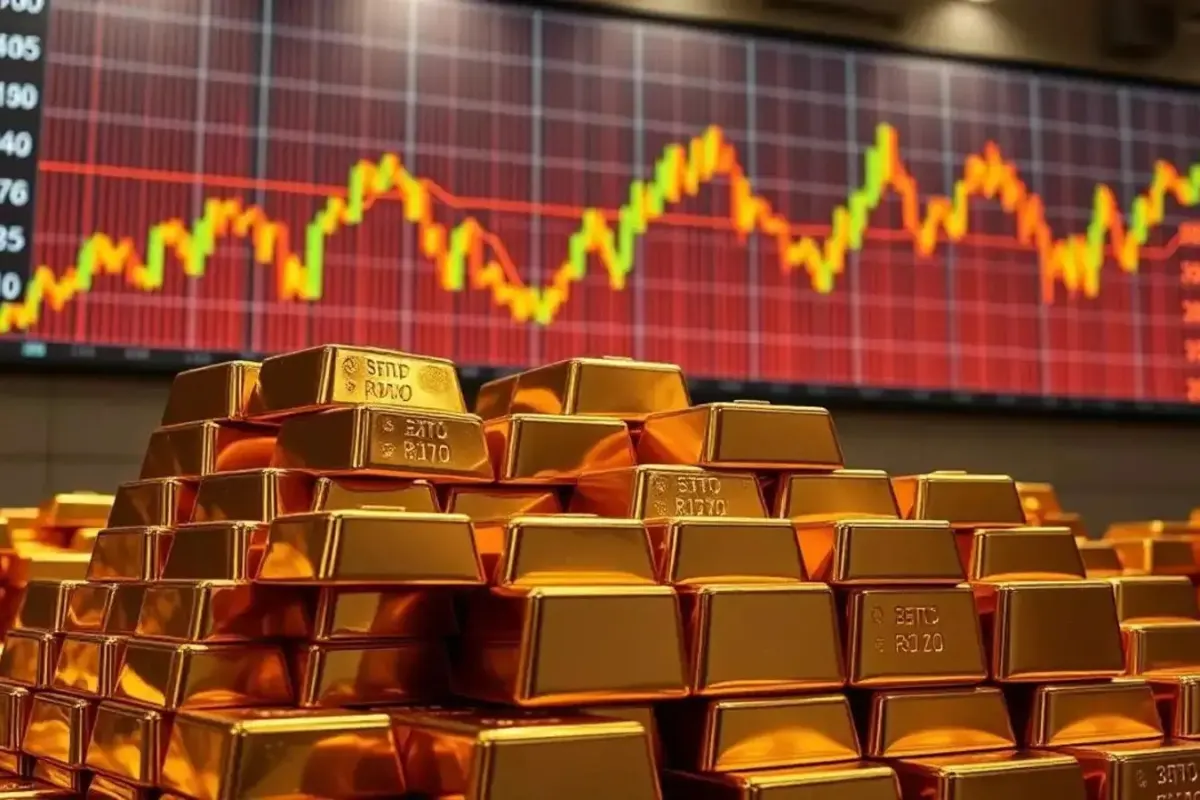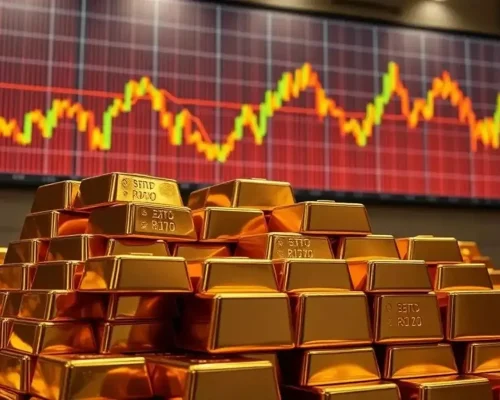For a long time, gold has been an integral part of the American dream, starting from miners who extracted gold from California rivers in 1849 till now when it is used as a part of a portfolio to protect against inflation. On October 8, 2025, the price of gold went beyond all the previous limits, going above $4,000 per ounce for the first time. It was an increase of 1.3% to $4,034.59 in spot trading. For U.S. investors ranging from Wall Street traders to the retirement savers in the middle of the country, this is not just a nice headline but a sign that there is a big change in the global finance system. The cause of this change is the shutdown of the U.S. government, the bets on the Fed rate cuts, and the uneasiness of the geographies. Gold Price, which has risen 54% so far this year and has been more successful than stocks, bitcoin, and oil is the most brilliant investment of this century. According to Bloomberg data. If one is thinking of a gold IRA in Texas or 401(k) diversification in Florida, then the knowledge of the current rally in the gold price is the most important thing for one to be able to handle the uncertainties of 2025.
This guide is a simple, everyday American explanation of the gold price surge, including the drivers, the forecasts, and the strategies. From why central banks are hoarding bars to how it fits your budget, we’ll equip you to decide if gold’s glow is right for your nest egg. As the metal market rises amid a shutdown that delays economic data, let’s examine the facts and make more informed choices.
Understanding the Gold Price Surge in 2025
The gold price didn’t hit $4,000 overnight; it’s the culmination of a perfect storm that’s propelled bullion from $2,000 two years ago to this apex. Spot gold’s 54% YTD gain eclipses the S&P 500’s 20% and bitcoin’s wild swings, making it 2025’s top asset, according to Reuters. For Americans, where gold ETFs hold $100 billion in assets, this rally underscores its role as a portfolio anchor amid 3% inflation and trade tensions.
Key Milestones in the 2025 Rally
- January Start: Opened at $2,650, buoyed by post-election Fed easing signals.
- March Peak: Touched $3,000 amid Trump’s tariff threats, echoing 1980s inflation highs adjusted for today.
- Summer Surge: Central bank purchases doubled to 1,000 tons quarterly, according to the World Gold Council.
- October Breakout: Crossed $4,000 on October 8, with silver tagging along at $48.85, near its record.
This ascent reflects gold’s timeless appeal: non-yielding yet inflation-proof, a hedge when the dollar wobbles.
Factors Driving the Record Gold Price
Gold’s flight isn’t random; it’s a reaction to a complex mix of economic, political, and global pressures that resonate deeply in the U.S., where 40% of households own precious metals, according to Gallup. The U.S. government shutdown, now in its eighth day, has frozen data releases, spurring safe-haven buys as investors brace for volatility.
Economic and Policy Catalysts
- Fed Rate Cuts: Traders price a 25-bps trim this month, with more in December. Lower rates make yield-less gold more attractive compared to bonds.
- Weak Dollar: Down 5% YTD, amplifying gold’s dollar-denominated shine for foreign buyers.
- Inflation Fears: At 3.2%, it erodes cash; gold preserves value, up 27% in 2024 alone.
- Government Shutdown: Delays GDP reports, heightening uncertainty, gold rose 2% during the 2018-19 impasse.
Geopolitics adds spice: Middle East tensions flare, Ukraine stalemates, and elections in France/Japan drive central banks to diversify their reserves, with India’s ETFs reaching $10 billion in AUM.
Gold Price Forecasts for Late 2025 and Beyond
Analysts are bullish, with WisdomTree eyeing $4,530 by Q3 2026 and Goldman Sachs/UBS hiking targets on ETF inflows. For Americans, this could mean annual returns of 12-15%, outpacing CDs at 4%.
Expert Projections Breakdown
| Firm | End-2025 Target | 2026 Peak | Key Assumption |
| WisdomTree | $4,200 | $4,530 | Continued Fed easing |
| Goldman Sachs | $4,100 | $4,400 | Central bank buys at 1,200 tons/year |
| UBS | $4,050 | $4,300 | Geopolitical risks persist |
| Deutsche Bank | $3,950 | $4,200 | ETF inflows double |
These forecasts hinge on no hawkish Fed pivot; Trump’s rate-cut push keeps momentum alive, according to UBS’s Giovanni Staunovo.
How the Gold Price Rally Impacts American Investors
For the 59 million U.S. households with IRAs, gold’s surge offers diversification, with a 5-10% allocation cut reducing portfolio volatility by 20%, according to Vanguard studies. Yet, with prices soaring, timing matters: Should you buy dips or wait for corrections?
Portfolio Strategies for U.S. Savers
- IRA Gold Rollover: Add physical bars via self-directed IRAs, offering tax-deferred growth, but with average fees of 1%.
- ETFs for Ease: GLD or IAU track spot prices with 0.4% expense ratios, $10 billion inflows in September.
- Physical Buys: Coins from APMEX or JM Bullion; store in home safes or banks for a $50 annual fee.
- Mining Stocks: Barrick Gold (up 30% YTD) amplifies gains but adds risk, diversify 2-3%.
Retirees in Arizona or young pros in New York: Gold hedges Social Security cuts or job market jitters, but cap at 10% to avoid overexposure.
Risks and Considerations in the Current Gold Price Boom
Gold’s glitter has pitfalls; it’s volatile, up 50% YTD, but prone to 20% pullbacks, like 2022’s dip. A Fed hawk turn or a resolved shutdown could stall the rally.
Potential Headwinds for Buyers
- Opportunity Cost: No dividends vs. S&P’s 1.5% yield; long holds beat short trades.
- Storage/Fees: Physical gold incurs premiums (5-10%) and insurance; ETFs sidestep this.
- Market Saturation: FOMO drives 30% of buys, according to Saxo; bubbles burst when tensions ease.
- Tax Traps: Short-term gains tax at income rates (up to 37%); long-term at 28%.
For risk-averse Americans, blended with bonds, gold’s negative correlation becomes particularly evident in downturns.
Central Banks and ETFs Fueling the Gold Price Momentum
Central banks shifted from sellers to buyers post-2008, accumulating over 1,000 tons annually since Russia’s 2022 reserve freeze. China’s 2025 purchases reached 300 tons, according to council data.
Institutional Drivers
- Reserve Diversification: 20% of global reserves are now gold, up from 10% in 2010, with India/PBOC leading the way.
- ETF Revival: Developed-market funds saw first inflows in five years; U.S. SPDR Gold Shares added $5 billion in Q3.
- Retail Rush: Platforms like Public.com report a 40% increase in gold trades among users.
This institutional backing stabilizes the gold price, making it a reliable hedge against the U.S. dollar.
Why the Gold Price Matters to Everyday Americans
Beyond charts, gold’s $4,000 milestone touches lives: It signals economic wobbles, with shutdowns delaying checks for 800,000 federal employees, while offering inflation protection for 70 million savers, according to AARP. From jewelry heirlooms in immigrant families to IRAs in Boomer retirements, it’s cultural currency.
In the flux of 2025, trade wars, rate dances, and gold price rallies remind us: Tangibles endure. As it climbs, consult advisors, buy smart, and remember: It’s not just metal, it’s peace of mind.





